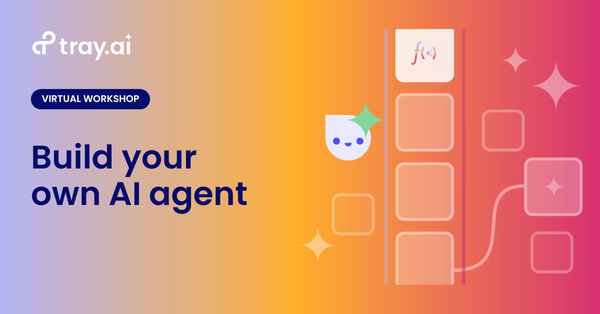As AI continues to evolve and transform how we work, it's clear that harnessing its full potential requires more than just excitement about its capabilities. The rapid adoption of AI in SaaS apps is creating a new challenge—misalignment across teams and processes—which is why it's crucial for organizations to take a strategic, thoughtful approach.
In this article, I discuss the steps businesses can take to avoid falling into the trap of AI misalignment and how a composable, adaptable mindset will set the foundation for long-term success with AI. I hope it sparks ideas for how your organization can take the next step in your AI journey.
Unlocking AI's potential amidst SaaS overload and technical debt
Generative AI presents exciting business opportunities, such as the ability to improve business processes, augment staff resources and reduce manual tasks. However, opportunities presented by this wave of AI-enabled SaaS apps come with fresh problems.
According to our research, in addition to SaaS bloat—55% of companies have more than 50 SaaS apps in their tech stack—AI misalignment is poised to become a new problem. For each app in their stack, 57% of executives plan to use the provided AI functionality as part of their AI business process strategy. However, "only 32% of practitioners and team leads state this will be the primary focus for their organization—and almost 20% of practitioners state their organizations don’t have an AI strategy as it relates to their tech stack and internal business processes."
Compounding this is the fact that U.S. companies are still battling crippling technical debt. A 2022 report found it would require $1.52 trillion to fix this problem and cost U.S. companies "$2.41 trillion a year in cybersecurity and operational failures, failed development projects, and maintenance of outdated systems."
AI has the potential to both exacerbate and alleviate this issue. "By 2027, 70% of professional developers will use AI-powered coding tools, up from less than 10% today," according to Gartner. On the other hand, implementing AI without clear direction or a solid ongoing management strategy will only create more technical debt.
To compete in the AI era, many companies are discovering the importance of transforming into autonomous enterprises by empowering teams to leverage AI for integrations and automation. Along with this, there's a growing need to continuously optimize workflows and deploy intelligent, iteratively learning knowledge agents.
Amid the flood of AI-enabled SaaS apps, organizations face a critical question: How can they take their first steps toward sustainably harnessing AI’s power and embark on the path to becoming an autonomous enterprise?
Key considerations when implementing AI solutions
I believe the real value of AI will be recognized when organizations start infusing it into new and existing business processes. As enterprises begin sketching out their AI implementation strategies, they must consider the following:
Governance, trustworthiness and scalability
There are a lot of questions about how AI can be safely and securely enabled across the organization, especially in a tech landscape where almost every SaaS app now offers its own form of AI functionality. Responsibly deploying AI features requires a careful, well-thought-out approach and foundational technology that can serve as the epicenter of the enterprise AI strategy.
One external consideration is to adopt a platform that can become the control center for end-to-end business processes where precise decisions can be made about where and how to infuse AI for the best business outcomes. Additionally, organizations should focus on outlining clear AI policies, including data handling and data security requirements and the acceptable use of AI tools.
Composable AI mindset
Build with a composable mindset to create more agile, flexible and efficient AI systems that can be quickly assembled and deployed to address evolving business needs. Prioritize tooling that can communicate well with all other applications in the tech stack, use tools with deep commitments to observability, and foster a culture of learning and experimentation with clear bounds that account for data governance.
Production readiness
To move beyond toys and experiments to real AI solutions, teams can begin by running robust self-evaluations on historical data and identifying when the organization is in beta on real-time AI processes. Leaders should then work to go beyond "zero-shot" AI projects, ensuring that AI can reflect on the work it has accomplished, rate the work completed, update it and complete it or escalate it to a human as necessary.
Adaptability
Organizations should stay nimble and avoid committing to any one AI vendor. The foundation model landscape has undergone significant change over the past year, with a wide range in price, latency and "perceived intellect" among the various models. By experimenting with multiple options, organizations can best prepare themselves to adopt the ideal model for each desired outcome.
Getting started with AI
By considering the points above, an organization can be better prepared to start experimenting with AI. While getting started can be daunting, there are three things companies can do to kickstart their initiatives.
1. Seek easy wins.
Start by looking at the organization and identifying where teams can easily solve an issue with AI. IT and customer service are two departments that can greatly and quickly benefit from AI and where an organization is likely to see more than just incremental efficiency gains. With exploration and internal team surveys, enterprises can identify clear opportunities across every department where they can begin the experimentation phase.
2. Create an internal knowledge agent to get internal data shops in order.
An organization’s unstructured data holds incredible value, but often it’s very difficult to use effectively. To capitalize on the coming AI wave, companies should create an internal knowledge agent that can be queried by staff if they need help with tasks, such as drafting responses to support tickets. This agent can also surface incorrect or outdated knowledge sources when incorrect or incomplete answers are rendered.
This initial exercise will help teams build their AI muscle and start thinking about organizing company data and prioritizing what data they want AI to have access to. Production AI agents must be underpinned by trustworthy data, and these steps will help with the process of cleaning and ingesting institutional knowledge.
3. Track AI usage to inform next steps.
Finally, inject well-defined universal uses of AI—text extraction, classification, summarization and so on—within the workflows that teams are currently executing. Tracking AI usage across the organization will allow AI teams to refine their prompt engineering techniques and help bring AI knowledge and thinking to new teams.
In conclusion
With the advent of AI, organizations across all industries are going to reimagine every business process. But as AI products flood the market, business and IT leaders must think strategically about how they implement AI. By focusing on the right foundational tools, strong governance and starting small, companies can successfully roll out a manageable and scalable AI integration strategy.
This article was originally published in Forbes Technology Council on August 9th, 2024.




